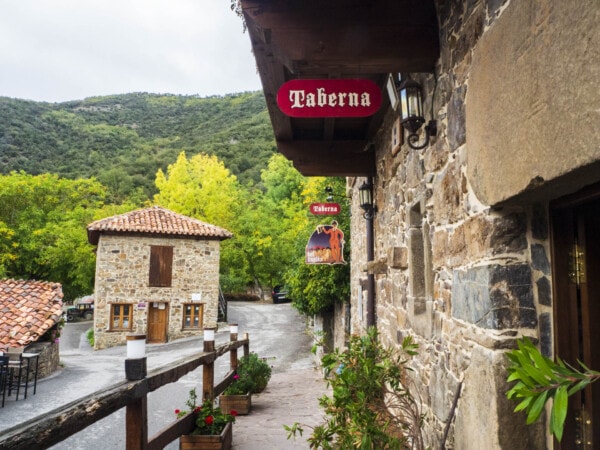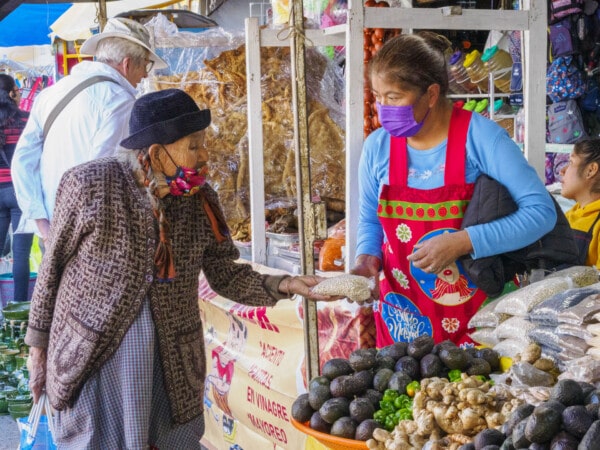A veil of smoke drifted up from the hand-made comal, curling its way from the hot fire to the chimney hole in the ceiling, warming the small adobe dining room with the aroma of the wood-fuelled fire.
To our right was the tomato room. Tables, shelves and baskets laden with hundreds of plump tomatoes, shiny as patent in multiple shades of red and green and purple, small as marbles, big as baseballs.
Standing at the comal, Elana welcomed us to the Chef’s table, set in front of her for the four of us, the rustic tabletop festooned with hand-made ceramic bowls of freshly cooked corn tortillas, guacamole and smoky salsa, with clay vases of colourful flowers, cloth napkins and polished silver. Ready for the six-course tasting menu, the multi-sensory experience she was about to immerse us in at La Cocina de Humo—The Smoke Kitchen.
Like the women in ancestral Oaxacan kitchens, the chefs in La Cucina de Humo are experts in using native ingredients like maize, beans, chilies, herbs and local fruits and vegetables in traditional and intricate ways, adept at grinding these ingredients on a metate and cooking over open fires and in clay ovens. The result is food with such depth and distinctive flavours and textures that UNESCO is helping to ensure that Oaxaca’s culinary heritage continues to thrive.
Thalía Barrios García, a young woman (not yet 30!) from the state’s mountainous south, opened La Cocina de Humo in 2021 to give diners the experience of eating in the smoke-filled kitchens in her remote hometown of San Mateo Yucutindoô. La Cocina de Humo is an offshoot of Levadura de Olla, Thalía’s first and main restaurant a few blocks away, which she opened in 2019.
We didn’t meet Thalía at either restaurant, but Elana, who comes from the same town and also works at Levadura de Olla, spoke warmly about her boss.
Elana and the other staff (ten other people from San Mateo Yucutindoô work in Thalía’s restaurants) receive health benefits, overtime and bonuses. Thalía supports her hometown’s local farmers by buying their produce for the restaurants, even though it’s 180 kilometres away and takes eight-to-ten hours for a round-trip delivery. It’s said the altitude and climate of San Mateo Yucutindoô result in produce that’s extraordinary—we agree.
“My great-great-grandmother, great-grandmother, and three of my aunts were all self-sufficient single moms. They all worked in their community,” Thalía said in an interview in Food & Wine. (Her mom is an an electrician.) “Now, I want to lift up my community.” At the entrance lobby to Levadura de Olla, we noticed ceramics and metates made in San Mateo Yucutindoô for sale, another way she’s supporting her community.
Critics feel the same delight as we do about Thalía’s food. In 2021, she was considered the most outstanding participant in the contest for the 50 Best Restaurants of Latin America and in the same year, she was named Food & Wine’s Best New Chef.
Part of the intimacy of the experience was dining around the comal in a room with just Chef Elana, her occasional assistant and us. La Cocina de Humo takes reservations for five time slots a day (9am, 11am, 1pm, 5pm and 7pm) in the room we were in that can accommodate six guests, and in a larger space near the entrance that can seat about a dozen diners.
The menu is free flowing, changing daily depending on what’s in season and what has inspired the chef. It’s served family style. Help yourself but save me some guacamole, I pleaded when the first course was served.
Vegetables hold the place of honour. But we started with a three-hour, dried-pork dish served with guacamole salsa. “This is perfection,” Gail said.
One of the joys was watching Elana make a most unusual tamale.
On the comal, she mothered a mixture of corn, garlic, onions, cilantro and guajillo chilis, then added flattened tomatoes and tomatillos. As the vegetables sizzled, Elana formed a masa of landrace corn (open-pollinated, not hybrid) into a ball, flattened it on a tortilla press and set it on the heat. When the tortilla was mucho calloso (half-cooked), she took it off, mashed it in a mortar and added it to the veggies on the comal. Setting the steaming bowl in front of us, she sprinkled it with a white confetti of fried queso fresco.
Another dish I especially liked was the earthy wild mushroom mole thickened with potatoes. And the yellow mole with white smoky beans umamied (is that a word?) by pork ribs. And variations of freshly made tortillas. There was no chicken on the menu, heralded by the loud crowing of a rooster in the back.
La Cocina de Humo doesn’t have a liquor license. But they serve a variety of ancestral beverages. I liked the corn /chayote/squash juice best, but the ticunchi, a fermented beverage made with the juice of papalometl agave and a plant called trebol, was far tastier than what we drank during our mezcal tour in the countryside.
The experience was extraordinary, especially because over the two hours we got to chat with Elena and learn more about her life.
While she looks young, Elena is the mother of three children aged 19, 16 and 12 who live in San Mateo Yucutindoô, cared for by her husband. She rarely gets home to see her family, only about once every three months. Although her husband supports her career choice, her parents are traditional and disapprove of her absence.
Like Thalía, Elana learned to cook from her grandmother.
Elana says she preferred to learn the art of tortilla-making and the subtle differences between chilis to entwining tomatoes and harvesting corn in the fields with her parents. My sixth sense tells me she is proud of her choice and the benefits it brings to her and to her family.
Not a measuring cup, weigh scale nor recipe book did we see. But online, I found Thalía’s recipe for an Oaxacan-Style Heirloom Tomato Salad.
There are 23 different varieties of tomatoes grown in Oaxaca, including some, like the red kidney-shaped jitomate riñón, which are unique to the area. I know, it’s January, months away from tomato season here in Vancouver. But this is the best we can do in sharing the pleasures of the Smoke Kitchen and hey, it’s mostly Mexican tomatoes in our grocery stores now.
Oaxacan-Style Heirloom Tomato Salad
Ingredients
For the Mint Vinaigrette
- 1/2 cup fresh mint leaves
- 1½ tbsp apple cider vinegar
- 1/3 cup extra-virgin olive oil
- 1/2 tsp coarse sea salt
- Freshly ground black pepper to taste
For the Beet Purée
- 2¼ pounds medium beets scrubbed clean
- 1½ cups rice
- Rind of 1 lemon
- ¾ cup extra-virgin olive oil
- 2 tsp coarse sea salt
- 1 tsp freshly ground black pepper
For the Tomato Salad
- ¾ pound heirloom tomatoes thinly sliced
- 1 medium tomatillo thinly sliced
- Freshly ground black pepper and coarse sea salt to taste
Instructions
- Rinse the mint leaves and gently pat dry between two paper towels. Lightly crush 1 teaspoon mint leaves to release their flavour and place in a Mason jar. Pour the vinegar over the mint, cover the jar with plastic wrap so the vinegar won’t react with the metal, then seal the lid. Let sit at room temperature in a dark place for 1 hour and then strain.
- In a bowl, combine the mint-infused vinegar with the remaining mint, olive oil, salt and pepper, and shake to emulsify.
- Put the beets in a foil pan with the rice and lemon rind, cover tightly with tin foil and barbecue or bake them at 400°F for about 45 minutes until a knife will easily pierce through the beets. The rice will burn and flavour the beets with smoke.
- Discard the burned rice and lemon rind. Let the beets cool, remove their skins and cut into small cubes so they’re easy to blend.
- Place the beets, olive oil, (don’t be shy; it needs ¾ cup), 1 teaspoon pepper and 2 teaspoons sea salt into a blender. Process until smooth, stopping to scrape down the sides for a silken texture. (Lick the spatula and you’re already a fan of this recipe.)
- Spread the beet purée on a serving plate. Arrange the tomato and tomatillo slices on top. Drizzle on the vinaigrette and top with the remaining mint leaves. Season to taste with salt and pepper. Serve immediately.
Cristina Potters has an informative website called Mexico Cooks! On it she says this about Cocina de Humo:
Si dios (el qué sea de su confianza) bajara al mundo de los mortales, sería para comer aquí. (“If god (whichever god you might trust) were to come from Heaven to this mortal world, it would be to eat here.”
Navigation
Davis, Janelle. “Eva Longoria calls this the ‘perfect dish’ in ‘Searching for Mexico”.” Recipe from Thalia Barrios García, La Cocina de Humo. CNN. April 8, 2023.
Potters, Cristina. “Thalía Barrios García and La Cocina de Humo, Oaxaca: A Do-Not-Miss in Oaxaca’s Capital.” Mexico Cooks. August 27, 2022.
Ray, Joe. “Drawing on Traditional Oaxacan Cuisine, These Two Restaurants Have Changed the Culinary Scene in the Mexican City.” Food & Wine. May 12, 2023.




























2 Responses
I would wish to eat there every day. Delicious and nutritious.
You would–the variety of flavour Elena creates with all those fresh veggies and assorted chilies is so satisfying.